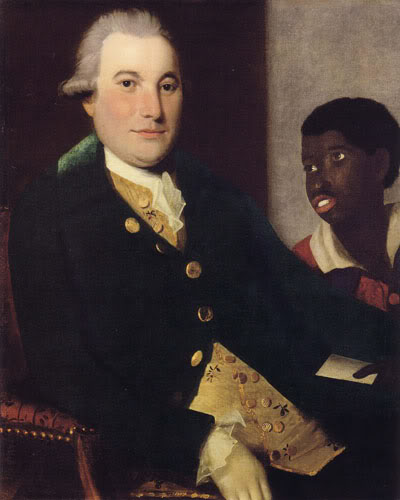
Do you know that racism, classism and sexism is inherent in art and the way it is displayed? Take another look. How are women portrayed in historical art, family portraiture or other paintings? How are servants portrayed? What about children? What about indigenous peoples or other ethnicities?
History is told from a particular lens or perspective. This is true whether it is art, literature, music or dance. This particular perspective limits what we see, what we remember and how we understand our past.
Read in full this article at the New Britain Museum of American Art blog, July 5, 2011 by curatorialintern. Here’s an excerpt:
Titus Kaphar uses art to confront history. Sometimes, he also stages interventions. Such is the case in Jaavon and the Unknown Gentleman. The painting is Kaphar’s response to Gentleman with Negro Attendant, a portrait by Ralph Earl from ca. 1785-88. (The two paintings hang side by side in the Colonial Gallery.)
Earl’s portrait depicts a large, well-dressed white man waited on by a young black boy. This kind of portrait – where a servant is portrayed only as a sign of the wealth of his master – was common in Colonial America.
As Kaphar elaborates, “In the original painting, Gentleman with Negro Attendant the black child is stripped of all identity. He has no name, grotesquely articulated features and is bereft of human dignity.
In Jaavon and the Unknown Gentleman the black figure is replaced with a living and particular child – my young neighbor.” In repainting Earl’s original work, Kaphar returns specificity to the figure of the black boy. The “gentleman”, however, becomes “unknown”, as Kaphar cuts holes in the canvas where the head and hands of the “gentleman” were once rendered. By changing the original title, Kaphar further shifts the underlying power structure in Earl’s portrait.
This reminds me that I need to start seeing, not simply looking. This is true for art, but also for novels and films too. It’s important to ask how are women and others portrayed? Who are designated as leaders? Who are active agents in the plot? Who causes actions to happen? Who merely reacts or responds?
Too much of what we view, read, or hear is loaded with sexist, classist and racist assumptions. So much so that we don’t even notice it – as the painting example above demonstrates. Unless we educate ourselves otherwise – and even then it’s difficult – we are blind to it all.
You may also like Power of Reframing and Prisons For Profit.